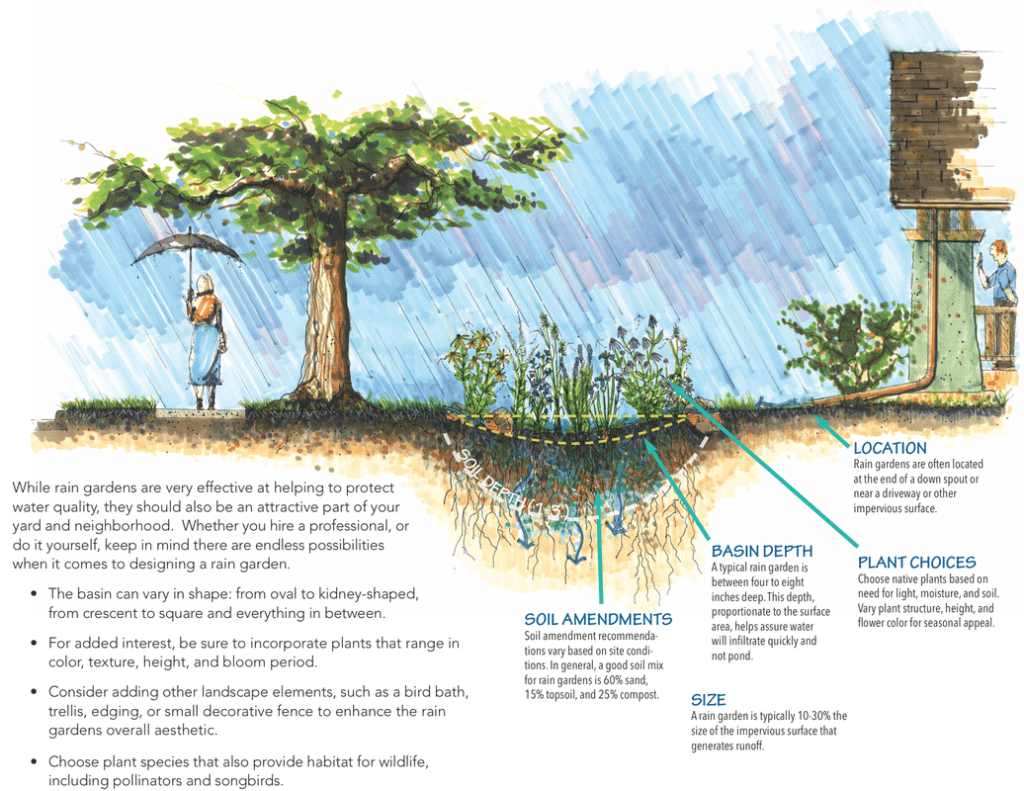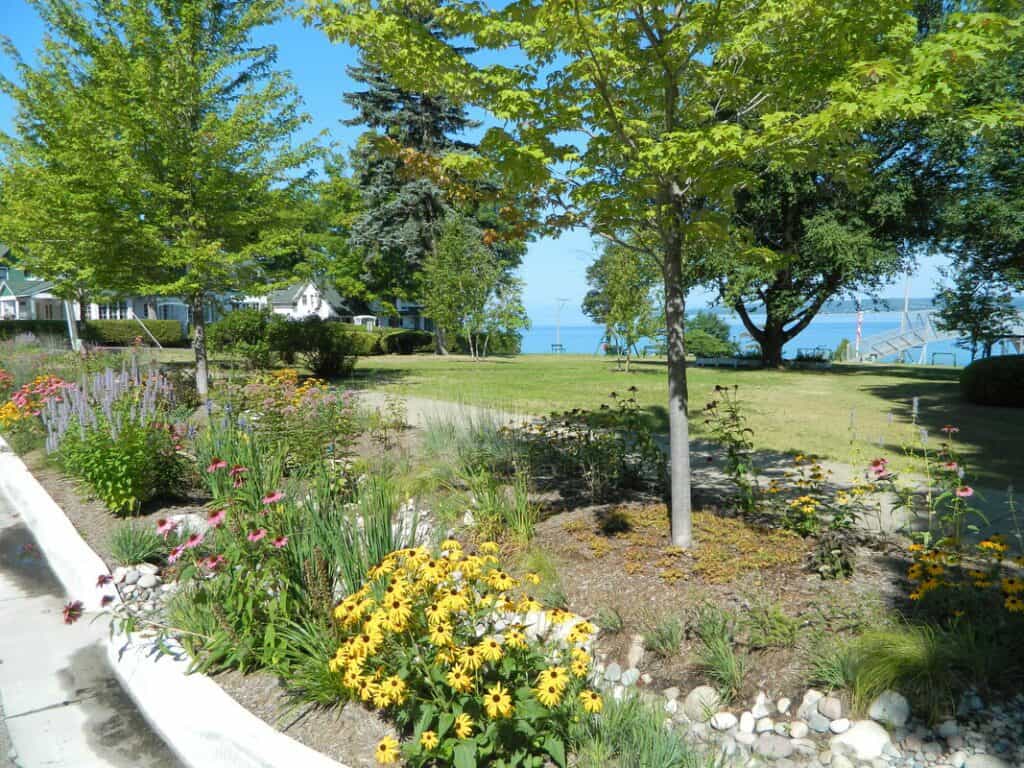What is a Rain Garden?
On the surface, a rain garden looks like an attractive garden. It may support habitat for birds and butterflies, it may be a formal landscape amenity, or it may be incorporated into a larger garden as a border or as an entry feature. What makes it a rain garden is in how it gets its water and what happens to that water once it arrives in the garden.
Rain gardens, also known as bioretention (“bio” meaning the use of plants and “retention” referring to the stormwater that is temporarily stored before it soaks into the ground) basins, allow stormwater to be both cleaned and reduced in volume, putting into practice the stormwater strategy:
Slow It Down, Spread It Out, and Soak It In
How Does a Rain Garden Work?
Below the surface of the garden, a number of processes are occurring which mimic the hydrologic action of a healthy forest. Soils are engineered and appropriate plants selected for the rain garden. The garden is a small bioretention cell in which stormwater is cleaned and reduced in volume once it enters the rain garden. Nitrogen and phosphorus levels and overall sediment loads in the stormwater are reduced by the action of the plants and growing media on the water. Multiple rain gardens over an area will have a positive cumulative effect on both the volume and quality of stormwater runoff.
Rain gardens offer many benefits including:
- Increasing the amount of water that filters into the ground, which recharges local and regional aquifers;
- Helping protect communities from flooding and drainage problems;
- Helping protect streams and lakes from pollutants carried by urban stormwater – lawn fertilizers and pesticides, oil and other fluids that leak from cars, and numerous harmful substances that wash off roofs and paved areas;
- Enhancing the beauty of yards and neighborhoods;
- Providing valuable habitat for birds, butterflies and many beneficial insects.

What Plants Are Best For Rain Gardens?
Many plant species are suitable for rain gardens; however, native plants are best. Here in Northern Michigan, native plants are considered those species that occurred here prior to European settlement.
Native plants have several characteristics that make them appealing as garden and landscaping plants:
- They are naturally adapted to the soils and weather conditions of the area, so they need little care once they’ve become established.
- They provide food and cover for wildlife.
- They improve the quality of the environment by slowing stormwater runoff, preventing erosion, and enriching the soil.

What’s the Best Location for a Rain Garden?
Rain gardens can be planted in either sun or shade, or somewhere in between. Locate them at least 10 feet away from any building to protect the foundation and never on top of a septic system. You will want to make sure the site has good drainage, too. Don’t be tempted to put the rain garden in a part of the yard where water already ponds because the goal of a rain garden is to encourage
infiltration, and soggy areas indicate where infiltration is slow.
- Locate the rain garden outside of a tree’s drip line to avoid cutting roots.
- Keep the rain garden away from utility lines and any easements.
- Do not build a rain garden in soil that has a high water table.
- Since a rain garden surface must be flat, the amount of grading required during construction increases with slope. Rain gardens should not be built on land with a slope greater than 12%.
- Dig a hole 18 inches deep and 6 inches in diameter (a post hole digger will suffice).
- Fill the hole to the top with water and let it drain (this will saturate the surrounding soil).
- Re-fill the hole with water and measure how quickly it drains using a yard stick. If the hole drains 3 inches in a 6-hour period, your local infiltration rate is 0.5 inches per hour.
- If the hole doesn’t drain completely in 48 hours, then this location doesn’t have good drainage. It may not be suitable for a rain garden unless the soil is amended or infiltration improved through mechanical means, such as placing an underdrain or tilling the native soils beneath the garden to improve infiltration. Conversely, if the site has soils that are potentially too well-drained, you may need to amend the soils with compost to enhance water retention and give the plants a boost.
You may want to consult a professional or other rain garden resource to determine the space requirements, but a general rule of thumb is a rain garden should cover the area equal to about 10-30% of its contributing drainage area. The depth of the rain garden also depends on a number of site factors, but a typical rain garden basin depth is about 4-8”.
How Much Does A Rain Garden Cost?
An average cost of a rain garden is about $8 per square foot, but depends on several factors including area, site preparation, plants (types, sizes, and quantity), and any additional accents or features.
Maintenance of your rain garden is critical during the first couple years after installation. The plants will need to receive plenty of water until they are well established. Mulching, weeding, and replacing plants that fail to thrive in the rain garden are all important maintenance tasks necessary for both the maximum success of the rain garden and to control invasive species that might infest the garden from nearby sources.
Refer to other rain garden resources to be sure your design works with site conditions and will result in the look you want.
- Soils are dry-mesic (medium moisture) to dry
- Full sun
- Maximum plant height= 36 in.
- Plants will tolerate periodic water infiltrations as well as dry periods
- Soils are wet mesic (moist but can dry up) to mesic
- Full sun to partial shade
- Maximum plant height= 6 ft.
- Plants will appreciate moist, but not soggy, soils.
Additional Rain Garden Resources
Tip of the Mitt Watershed Council recommends the following publications, websites and service providers to help you learn more about installing and maintaining a rain garden.
Rain Gardens: A How-To Manual for Homeowners
(Wisconsin Department of Natural Resources Publication PUB-WT-776 2003/University of Wisconsin-Extension Publication GWQ037)
Blue Thumb: Planting for Clean Water
http://www.bluethumb.org
Low Impact Development Center
www.lowimpactdevelopment.org
Native Plants
University of Michigan Herbarium
The goals of this Michigan Flora Website are to present, in a searchable and browsable form, the basic information about all vascular plants known to occur outside of cultivation in the state. Searchable by common name, scientific name, genus, species and a whole host of other categories, it includes lots of information and a wealth of photos of native plants.
www.michiganflora.net
Wild Ones
A national nonprofit organization that promotes the use of native plants in private and public landscaping.
www.wildones.org
Tip of the Mitt Document Resources
| Title | Categories | Link | hf:doc_categories |
|---|---|---|---|
| Rain Garden Mural: Inspiring Nature-based Stormwater Solutions | Brochures, Native Plants, Rain Gardens | brochures native-plants rain-gardens guides | |
| Northern Michigan’s Native Plants | Guides for Homeowners, Native Plants, Rain Gardens | guides native-plants rain-gardens | |
| Native Plants of Northern Michigan | Guides for Homeowners, Native Plants, Rain Gardens | guides native-plants rain-gardens | |
| How to Plant A Rain Garden | Brochures, Guides for Homeowners, Native Plants, Rain Gardens | brochures guides native-plants rain-gardens | |
| Grand Traverse Bay Watershed Center Waterfront Resource Guide | Brochures, Greenbelts, Guides for Homeowners, Native Plants, Nature Based Stormwater Solutions, Property Owner Permit Guides, Rain Gardens, Shorelines & Streambanks | brochures greenbelts guides native-plants nature-based-stormwater-solutions property-owner-permit-guides rain-gardens shorelines-streambanks |

